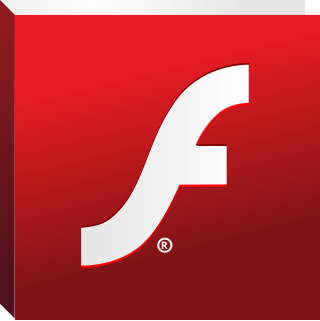Related Research Articles
Adobe Flash is a discontinued multimedia software platform used for production of animations, rich internet applications, desktop applications, mobile apps, mobile games, and embedded web browser video players.

Macromedia, Inc., was an American graphics, multimedia, and web development software company (1992–2005) headquartered in San Francisco, California, that made products such as Flash and Dreamweaver. It was purchased by its rival Adobe Systems on December 3, 2005.
Adobe Creative Suite (CS) is a discontinued software suite of graphic design, video editing, and web development applications developed by Adobe Systems.

Adobe ColdFusion is a commercial rapid web-application development computing platform created by J. J. Allaire in 1995. ColdFusion was originally designed to make it easier to connect simple HTML pages to a database. By version 2 (1996) it had become a full platform that included an IDE in addition to a full scripting language.
SWF is a defunct Adobe Flash file format that was used for multimedia, vector graphics and ActionScript.

Adobe Shockwave is a discontinued multimedia platform for building interactive multimedia applications and video games. Developers originate content using Adobe Director and publish it on the Internet. Such content could be viewed in a web browser on any computer with the Shockwave Player plug-in installed. MacroMind originated the technology; Macromedia acquired MacroMind and developed it further, releasing Shockwave Player in 1995. Adobe then acquired Shockwave with Macromedia in 2005. Shockwave supports raster graphics, basic vector graphics, 3D graphics, audio, and an embedded scripting language called Lingo.
A Rich Internet Application is a web application that has many of the characteristics of desktop application software. The concept is closely related to a single-page application, and may allow the user interactive features such as drag and drop, background menu, WYSIWYG editing, etc. The concept was first introduced in 2002 by Macromedia to describe Macromedia Flash MX product. Throughout the 2000-s, the term was generalized to describe browser-based applications developed with other competing browser plugin technologies including Java applets, Microsoft Silverlight.

Apache Flex, formerly Adobe Flex, is a software development kit (SDK) for the development and deployment of cross-platform rich web applications based on the Adobe Flash platform. Initially developed by Macromedia and then acquired by Adobe Systems, Adobe donated Flex to the Apache Software Foundation in 2011 and it was promoted to a top-level project in December 2012.

Web conferencing is used as an umbrella term for various types of online conferencing and collaborative services including webinars, webcasts, and web meetings. Sometimes it may be used also in the more narrow sense of the peer-level web meeting context, in an attempt to disambiguate it from the other types known as collaborative sessions. The terminology related to these technologies is exact and agreed relying on the standards for web conferencing but specific organizations practices in usage exist to provide also term usage reference.
Adobe Flash Player is computer software for viewing multimedia content, executing rich Internet applications, and streaming audio and video content created on the Adobe Flash platform. It can run from a web browser as a browser plug-in or independently on supported devices. Originally created by FutureWave under the name FutureSplash Player, it was renamed to Macromedia Flash Player after Macromedia acquired FutureWave in 1996. It was then developed and distributed by Adobe as Flash Player after Adobe acquired Macromedia in 2005. It is currently developed and distributed by Zhongcheng for users in China, and by Harman International for enterprise users outside of China, in collaboration with Adobe.

Adobe Flash Lite is a discontinued lightweight version of Adobe Flash Player, a software application published by Adobe Systems for viewing Flash content. Flash Lite operates on devices that Flash Player cannot, such as mobile phones and other portable electronic devices like Wii, Chumby and Iriver.
Adobe Connect is a software suite for remote training, web conferencing, presentation, and desktop sharing. All meeting rooms are organized into 'pods'; with each pod performing a specific role. Adobe Connect was formerly part of the Adobe Acrobat family and has changed names several times.
Flash Video is a container file format used to deliver digital video content over the Internet using Adobe Flash Player version 6 and newer. Flash Video content may also be embedded within SWF files. There are two different Flash Video file formats: FLV and F4V. The audio and video data within FLV files are encoded in the same way as SWF files. The F4V file format is based on the ISO base media file format, starting with Flash Player 9 update 3. Both formats are supported in Adobe Flash Player and developed by Adobe Systems. FLV was originally developed by Macromedia. In the early 2000s, Flash Video was the de facto standard for web-based streaming video. Users include Hulu, VEVO, Yahoo! Video, metacafe, Reuters.com, and many other news providers.

Jeremy D. Allaire is an American technologist and Internet entrepreneur. He is CEO and founder of the digital currency company Circle and chairman of the board of Brightcove. With his brother JJ Allaire, he is a co-founder of the Allaire Corporation in 1995, which had an IPO in January 1999 and was acquired by Macromedia in 2001. Allaire was chief technology officer (CTO) of Macromedia after the acquisition and helped develop the Macromedia MX platform.
Adobe Media Server (AMS) is a proprietary data and media server from Adobe Systems. This server works with the Flash Player and HTML5 runtime to create media driven, multiuser RIAs. The server uses ActionScript 1, an ECMAScript based scripting language, for server-side logic. Prior to version 2, it was known as Flash Communication Server. Prior to version 5, it was known as Flash Media Server. In February 2019, Adobe Systems Incorporated granted Veriskope Inc rights to further develop, resell, and extend distribution of the software product.
Macromedia Central was a runtime environment developed by Macromedia for developing application software that runs on different operating systems and are distributed over the Internet.
FutureWave Software, Inc. was a software development company based in San Diego, California. The company was co-founded by Charlie Jackson and Jonathan Gay on January 22, 1993. VP of Marketing was Linda Michelle Alsip, who also came from Silicon Beach Software, then Aldus Corporation.
Adobe Animate is a multimedia authoring and computer animation program developed by Adobe.

Adobe Shockwave Player was a freeware software plug-in for viewing multimedia and video games created on the Adobe Shockwave platform in web pages. Content was developed with Adobe Director and published on the Internet. Such content could be viewed in a web browser on any computer with the Shockwave Player plug-in installed. It was first developed by Macromedia and released in 1995; it was later acquired by Adobe Systems in 2005.
References
- ↑ Gay, Jonathan. "The History of Flash". Adobe. Archived from the original on 2007-10-26. Retrieved 2007-11-10.
- ↑ Gay, Jonathan. "The History of Flash". Adobe. Archived from the original on 2007-10-26. Retrieved 2007-11-10.
- ↑ Gay, Jonathan. "The History of Flash". Adobe. Archived from the original on 2006-07-17. Retrieved 2007-11-10.
- ↑ Coale, Kristi (1997-01-06). "Macromedia Rides The FutureWave". Wired. Archived from the original on 2008-12-31. Retrieved 2007-11-10.
- ↑ Dowdell, John (2006-07-26). "Zaphod emulates Tin Can". Adobe. Archived from the original on 2007-06-19. Retrieved 2007-11-10.
- ↑ Towes, Kevin (2002-12-02). "Preface to Macromedia Flash Communications Server MX". O'Reilly. Archived from the original on 2008-02-09. Retrieved 2007-11-10.
- ↑ Gay, Jonathan. "The History of Flash". Adobe. Archived from the original on 2006-07-17. Retrieved 2007-11-10.
- ↑ "Technology Breakdown". Adobe. Retrieved 2007-11-10.
- ↑ "Adobe to acquire Macromedia". Adobe. Archived from the original on 2005-04-20. Retrieved 2007-11-10.
- ↑ "Macromedia Management Team". Macromedia. Archived from the original on 2008-01-12. Retrieved 2007-11-10.
- ↑ "About Software as Art". Software as Art. Archived from the original on 2007-10-21. Retrieved 2007-11-10.
- ↑ "Flash Co-Creator Jonathan Gay Responds To Steve Jobs". ColdHardFlash. May 18, 2010.
- ↑ "Flash Co-Founder Jonathan Gay's New Video Software". ColdHardFlash. May 15, 2013.